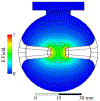Transformative Technology for FLASH Radiation Therapy
- PMID: 38240007
- PMCID: PMC10795821
- DOI: 10.3390/app13085021
Transformative Technology for FLASH Radiation Therapy
Abstract
The general concept of radiation therapy used in conventional cancer treatment is to increase the therapeutic index by creating a physical dose differential between tumors and normal tissues through precision dose targeting, image guidance, and radiation beams that deliver a radiation dose with high conformality, e.g., protons and ions. However, the treatment and cure are still limited by normal tissue radiation toxicity, with the corresponding side effects. A fundamentally different paradigm for increasing the therapeutic index of radiation therapy has emerged recently, supported by preclinical research, and based on the FLASH radiation effect. FLASH radiation therapy (FLASH-RT) is an ultra-high-dose-rate delivery of a therapeutic radiation dose within a fraction of a second. Experimental studies have shown that normal tissues seem to be universally spared at these high dose rates, whereas tumors are not. While dose delivery conditions to achieve a FLASH effect are not yet fully characterized, it is currently estimated that doses delivered in less than 200 ms produce normal-tissue-sparing effects, yet effectively kill tumor cells. Despite a great opportunity, there are many technical challenges for the accelerator community to create the required dose rates with novel compact accelerators to ensure the safe delivery of FLASH radiation beams.
Keywords: FLASH effect; particle accelerators; radiation therapy.
Conflict of interest statement
Billy W. Loo Jr. is an employee of Stanford University School of Medicine. Dr. Billy W. Loo Jr. has received research support from Varian Medical Systems. He is a co-founder and board member of TibaRay. Reinhard Schulte is employed by Loma Linda University, School of Medicine. Dr. Schulte has received research funding by Grant R44CA257178 “Ultrafast and Precise External Beam Monitor for FLASH and Other Advanced Radiation Therapy Modalities” from the National Cancer Institute awarded to Peter Friedman (PI), Integrated Sensors, LLC. The funder had no role in the design of the study; in the collection, analysis, or interpretation of data; in the writing of the manuscript; or in the decision to publish the results. The United States Government has rights to patents pursuant to Contract No. DE-AC52–07NA27344 between the United States Department of Energy and Lawrence Livermore National Security, LLC for the operation of Lawrence Livermore National Laboratory. For SES, Opcondys, Inc. is a for-profit company and may profit from the technologies described in this paper.
Figures



















Similar articles
-
The Black Book of Psychotropic Dosing and Monitoring.Psychopharmacol Bull. 2024 Jul 8;54(3):8-59. Psychopharmacol Bull. 2024. PMID: 38993656 Free PMC article. Review.
-
Management of urinary stones by experts in stone disease (ESD 2025).Arch Ital Urol Androl. 2025 Jun 30;97(2):14085. doi: 10.4081/aiua.2025.14085. Epub 2025 Jun 30. Arch Ital Urol Androl. 2025. PMID: 40583613 Review.
-
Systematic review and economic analysis of the comparative effectiveness of different inhaled corticosteroids and their usage with long-acting beta2 agonists for the treatment of chronic asthma in adults and children aged 12 years and over.Health Technol Assess. 2008 May;12(19):iii-iv, 1-360. doi: 10.3310/hta12190. Health Technol Assess. 2008. PMID: 18485271
-
A rapid and systematic review of the clinical effectiveness and cost-effectiveness of paclitaxel, docetaxel, gemcitabine and vinorelbine in non-small-cell lung cancer.Health Technol Assess. 2001;5(32):1-195. doi: 10.3310/hta5320. Health Technol Assess. 2001. PMID: 12065068
-
EORTC guidelines for the use of erythropoietic proteins in anaemic patients with cancer: 2006 update.Eur J Cancer. 2007 Jan;43(2):258-70. doi: 10.1016/j.ejca.2006.10.014. Epub 2006 Dec 19. Eur J Cancer. 2007. PMID: 17182241
Cited by
-
Feasibility study of high-power electron linac for clinical X-ray ROAD-FLASH therapy system.Front Med Eng. 2024;2:1382025. doi: 10.3389/fmede.2024.1382025. Epub 2024 Jun 16. Front Med Eng. 2024. PMID: 39925363 Free PMC article.
-
Navigating the Critical Translational Questions for Implementing FLASH in the Clinic.Semin Radiat Oncol. 2024 Jul;34(3):351-364. doi: 10.1016/j.semradonc.2024.04.008. Semin Radiat Oncol. 2024. PMID: 38880544 Free PMC article. Review.
-
FLASH Radiotherapy: Benefits, Mechanisms, and Obstacles to Its Clinical Application.Int J Mol Sci. 2024 Nov 21;25(23):12506. doi: 10.3390/ijms252312506. Int J Mol Sci. 2024. PMID: 39684218 Free PMC article. Review.
-
FLASH Radiotherapy: Expectations, Challenges, and Current Knowledge.Int J Mol Sci. 2024 Feb 22;25(5):2546. doi: 10.3390/ijms25052546. Int J Mol Sci. 2024. PMID: 38473799 Free PMC article. Review.
-
Comparison of secondary radiation dose between pencil beam scanning and scattered delivery for proton and VHEE radiotherapy.Med Phys. 2025 Jun;52(6):4775-4784. doi: 10.1002/mp.17700. Epub 2025 Feb 19. Med Phys. 2025. PMID: 39972099 Free PMC article.
References
-
- Favaudon V; Caplier L; Monceau V; Pouzoulet F; Sayarath M; Fouillade C; Poupon M-F; Brito I; Hupé P; Bourhis J; et al. Ultrahigh dose-rate FLASH irradiation increases the differential response between normal and tumor tissue in mice. Sci. Transl. Med 2014, 6, 245ra93. - PubMed
-
- Bourhis J; Sozzi WJ; Jorge PG; Gaide O; Bailat C; Duclos F; Patin D; Ozsahin M; Bochud F; Germond J-F; et al. Treatment of a first patient with FLASH-radiotherapy. Radiother. Oncol 2019, 139, 18–22. - PubMed
-
- Gaide O; Herrera F; Sozzi WJ; Gonçalves Jorge P; Kinj R; Bailat C; Duclos F; Bochud F; Germond J-F; Gondré M; et al. Comparison of ultra-high versus conventional dose rate radiotherapy in a patient with cutaneous lymphoma. Radiother. Oncol 2022, 174, 87–91. - PubMed
-
- Vozenin M-C; Bourhis J; Durante M Towards clinical translation of FLASH radiotherapy. Nat. Rev. Clin. Oncol 2022, 19, 791–803. - PubMed
